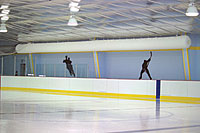
In Gizmology, dehumidifiers utilize brine that is leaving the rink floor on the way to the chiller. This return brine is pumped through a moisture-removal coil in the dehumidifier.
The moisture-removal coil lowers the dew point temperature of the return air from the arena, as well as from the outdoor makeup air for the arena.
After the moisture is removed, the air to be delivered to the arena is reheated using a "free" heat source. Part of the compressor waste heat is utilized for dehumidification reheat, which creates a low relative humidity in the supply airstream.
On a National Hockey League (NHL®) size rink, the supply air represents a cooling load of 216,000 Btuh on the rink because the 65 degree F air must be cooled to the 45 degree room temperature by the ice rink chiller.
The brine-based dehumidifier uses no natural gas and the compressor waste heat is available for winter heat.
Energy Savings
According to Tom Backman of BRR Technologies, several arenas, in locations ranging from the Midwest to the Southeast United States, now have the newer ice arena dehumidifiers."They have seen energy and performance benefits. Some rink managers that did not have dehumidifiers have noticed the humidity problems cease with no added utility costs when compared to operation without dehumidification."
Jaime Klasinski, cofounder of Ice Hawks Arena, Stevens Point, Wis., installed the dehumidifier in 2002. He said, "This system runs off of waste heat from the compressors. It has worked flawlessly since it was installed with no noticeable effect to our utility."
Grant Fitch, arena manager for the Saint Michael-Albertville Arena in Albertville, Minn., said, "The wasted heat is being reclaimed from the compressors and used in the dehumidification process." He calculated that the system would pay for itself in one year, based on the energy savings.
"The installation process was very smooth," he said. "When we installed the ice, the outside temperature was 87 degrees, and we had no moisture problems at all."
For more information, visit www.brrtechnologies.com.
Publication date: 07/04/2005

Report Abusive Comment